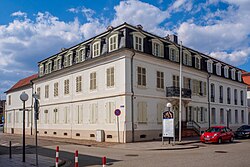City Museum Zweibrücken
 Petrihaus, Herzogstrasse 9 |
|
| Data | |
|---|---|
| place | Zweibrücken |
| Art |
Local museum
|
| opening | April 18, 1926 |
| management |
Charlotte luck
|
| Website | |
| ISIL | DE-MUS-167113 |
The Zweibrücken City Museum presents the history of the city of Zweibrücken and the former Duchy of Pfalz-Zweibrücken .
history
The Palatinate historian and local researcher Albert Becker had the idea of a Zweibrücker Heimatmuseum in 1913 and concretized his ideas in 1914 in a lecture to the “Historical Association of Mediomatrics for the West Palatinate”. The aim was to create a non-public collection of exhibits from the city's history. The First World War interrupted the preparations, however, so that a historically oriented local history museum was only opened in the Spitalturm on April 18, 1926. The first director was the initiator Albert Becker. However, this first museum was destroyed on March 14, 1945 when the old town was bombed.
In 1948 the lawyer Max Schuler was entrusted by the French military government with the reconstruction of the museum. He began with the recovery of historical debris finds and expanded the collection further. In 1957 the collection found a temporary home in the Villa Froelich made available by the city . However, the collection only became publicly accessible when it moved to the “Petrihaus” donated by Gertrud von Kraußer in the baroque ducal suburb. With the support of the Historisches Museum der Pfalz , the museum was set up as the local history museum of the city of Zweibrücken and was officially opened on October 28, 1961.
Until 1993 it was looked after by municipal administrative employees on a part-time basis. In that year the "Friends of the Museum Zweibrücken" was founded and the city hired Charlotte Glück-Christmann, a historian for the museum for the first time, to take an inventory of the museum's holdings and develop a concept. The Petrihaus had to be closed during this time due to the need for renovation. Until the general renovation, the exhibitions were therefore held at alternative locations. From 2004 the Petrihaus was completely renovated and modernized and in 2006 it was reopened as a museum building.
building
In 1756, Duke Christian IV decided to build a new suburb. The baroque Petrihaus is one of the few privately built houses in the ducal suburb. It was built in 1768 by the court gardener Ernst August Bernhard Petri . The house has not changed much to this day. The two-story corner building with a mansard roof and a staircase in front has five window axes on the front. The middle one is highlighted by the entrance on the ground floor and a large door with a balcony and wrought iron railing. In the rear area of the baroque building, an extension was built for barrier-free access.
The building is a historical monument.
Exhibitions
The city museum presents a permanent exhibition on the history of Zweibrücken, supplemented by changing special exhibitions.
One focus of the permanent exhibition is the baroque period , in which Zweibrücken experienced a heyday. Unique exhibits such as B. the valuable Zweibrücker porcelain , the Mozart piano from the Zweibrücken workshop Baumann and important works of the Pfalz-Zweibrücker painting school.
The exhibition run jointly with the Siebenpfeiffer Foundation “Schau! Platz Freiheit. Democratic tradition in Westrich ”traces the roots of the German democracy movement .
Web links
Individual evidence
- ↑ Help for the Zweibrücken treasure chest. In: Palatine Merkur . October 12, 2018, accessed October 19, 2019 .
- ^ General Directorate for Cultural Heritage Rhineland-Palatinate (ed.): Informational directory of cultural monuments - District-free city of Zweibrücken. Mainz 2020, p. 5 (PDF; 4.3 MB; Herzogstraße 9/11).
Coordinates: 49 ° 15 ′ 4.7 ″ N , 7 ° 21 ′ 37.5 ″ E
